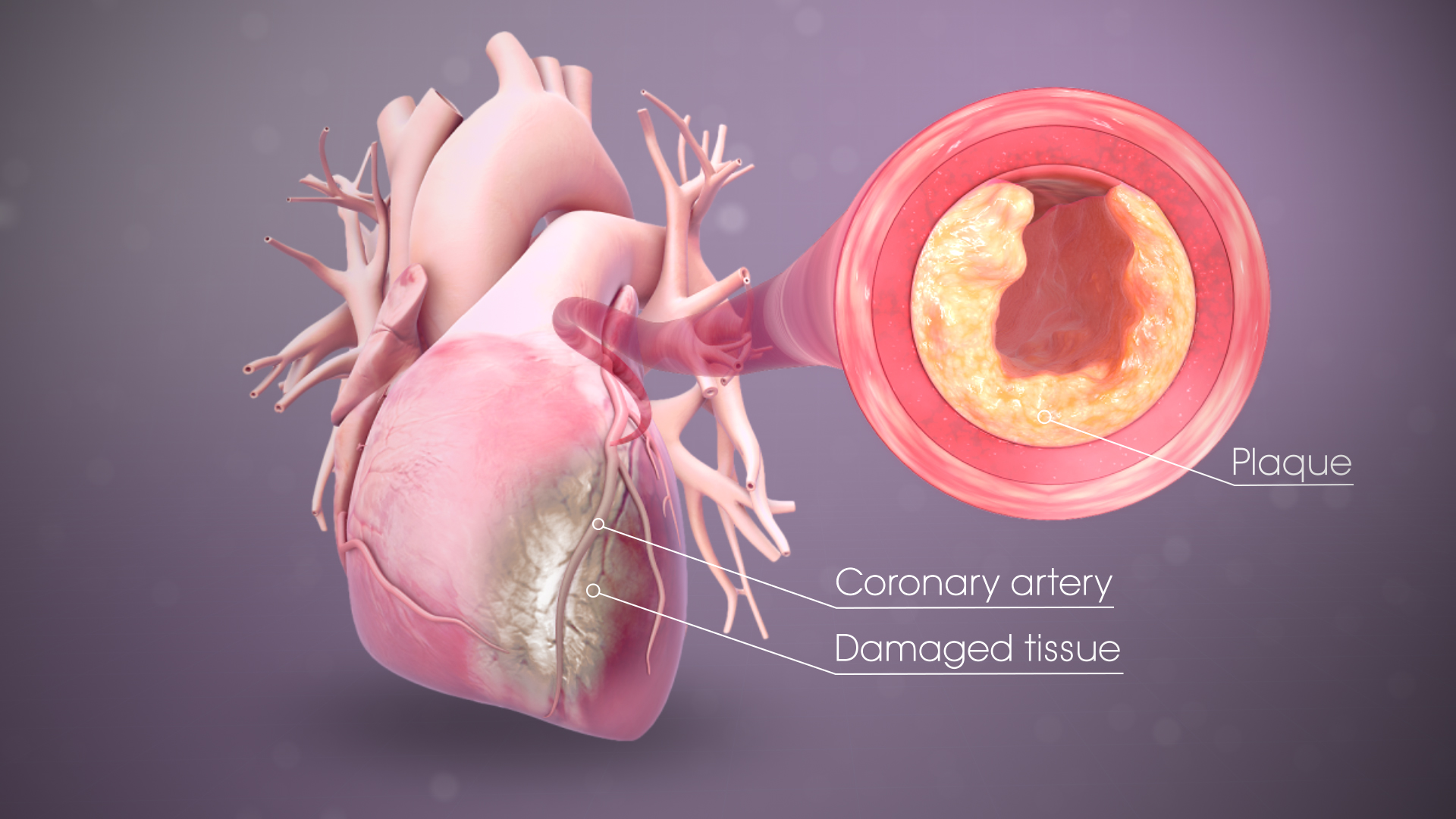Commonly known as a heart attack, a Myocardial (heart muscle) infarction (tissue death) happens when heart muscle is damaged because plaque buildup in a coronary artery compromises the blood flow to it. This can cause heart failure, an irregular heartbeat, cardiogenic shock, or cardiac arrest.

3D medical animation showing plaque buildup in a coronary artery compromising the blood flow to it.
Just like any part of the body, heart tissue requires a constant supply of oxygen. The coronary arteries deliver oxygenated blood to the heart; and if any of these arteries are blocked, portions of the heart muscle can be deprived of oxygen causing, potentially, serious damage to the heart.
Symptoms
The most common symptoms of a heart attack are chest pain and shortness of breath. The chest pain can feel like the pain of indigestion. Other symptoms include,
Pressure or tightness in chest
Nausea
Vomiting
Dizziness
Sweating
Anxiety
A faster heart rates
Discomfort or pain in the upper body, usually, the arm, breastbone, jaw, and upper back.
About 25% of heart attacks happen without any prior symptoms, known as “silent ischemia” that for unknown reasons is painless. People with diabetes often don’t have any symptoms.
Causes
There are multiple factors for the buildup of plaque, such as bad cholesterol i.e. LDL cholesterol, saturated fats most commonly found in butter, cheese and beef, trans fat usually found in processed foods. Smoking tobacco is another big reason that leads to the formation of plaque and increases the risk of heart attack. People with high blood pressure are at greater risk of a heart attack.
Treatment
Doctors diagnose heart attack by checking the patient for an irregular heart-beat, and judging the symptom severity by taking the patient history.
Diagnostic tests include:
Electrocardiogram (ECG) to measure the electrical activity of the heart.
Blood Test to check heart-exclusive proteins like Troponin which tend to spill out during a cardiac episode.
Angiogram to look at arterial blockage
An echocardiogram to identify improperly functioning areas in the heart.
Cardiologists often explain that “time is muscle”, as during a heart attack every little bit counts. Every minute is crucial, the person should seek treatment immediately. Medications and medical procedure are used to restore oxygen supply and demand balance.
Beta- blockers are used to slow the heart thereby reducing the oxygen demand.
Nitrates are used to open the blood vessels by dilating the vessels to improve the blood flow
Anti-coagulants help in preventing blood from clotting
Statin reduces the blood cholesterol level
Ace-inhibitors reduce the blood pressure
Procedures include:
Angioplasty – the Surgeon inserts a long, thin tube called a catheter to reach the blockage, and inflates a small balloon attached to the catheter to reopen the artery. A metal stent at the site of the blockage is implanted to keep the artery open.
Coronary Artery Bypass Graft (CABG) – the surgeon takes blood vessel from another part of the body and uses it to reroute the patient’s arteries, so the blood can flow around the blockage.
Multiple steps can be taken to prevent a heart attack. Lifestyle changes including a heart-healthy diet with whole grains, vegetables, fruits and lean protein; reducing sugar, saturated fat, trans fat, and cholesterol from diet. Exercising also improves cardiovascular health. Apart from this refraining from smoking significantly reduces the risk of a heart attack.
Disclaimer: The information in no way constitutes, or should be construed as medical advice. Nor is the above article an endorsement of any research findings discussed in the article an endorsement for any of the source publications.








